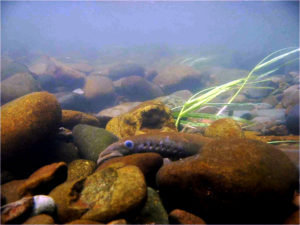ara Gallagher spends a lot of time on the Golden Gate Bridge, scanning the cold waters below for evidence to solve a really challenging math problem.
Gallagher, a graduate student at San Francisco State University who collaborates with Golden Gate Cetacean Research, knows the Bay’s porpoise population is rebounding, from zero as recently as a decade ago to at least 600. Although all those porpoises aren’t fishing for food in the Bay at the same time – they likely come and go from the larger population of about 2,500-3,000 along the outer coast – the inland waters have clearly become popular with the porpoises. What she wants to know is: What does that mean about the Bay ecosystem itself, and how could you start to tell?
Related video: How the porpoises returned to San Francisco Bay
ne way, Gallagher thinks, would be to know what the porpoises eat, and how much of it they’re eating. So she stands on the bridge, and watches for the distinctive, triangle-shaped dorsal fins of the porpoises as they head west, ahead of the ebb tide. When she spots one, her tracking work begins.
With a stopwatch and fancy pair of binoculars – a theodolite – that marks the distance between two points, Gallagher records the time it takes a porpoise to swim between two spots where it surfaces. That lets her build a data set of porpoises’ swim velocities by calculating the distance divided by the time. And swim speed is just one variable in a larger mathematical model that will help her estimate how much energy a porpoise needs on a daily basis.
Working off similar computations developed for sea lions and minke whales, Gallagher also needs to figure in things like the size and surface area of the harbor porpoises, as well as what their metabolic rate might be – an estimation that will also have to account for different bodily demands for energy, such as growth or pregnancy. Another big factor is the water temperature.
Once she estimates the energy needs of a single porpoise, she can scale that up to figure out how much the whole harbor population requires. That information, in turn, will be her foundation for determining how much prey the porpoises need to sustain themselves: their food budget.
Finally, at the end of all that calculating, she’ll get an idea of how much carbon the porpoises use in the San Francisco Bay ecosystem. Carbon is a unit of biological currency that can be used to compare the impact of vastly different organisms such as algae, fishes and birds, in the ecosystem. Her data from the bridge becomes one small part of a model of the entire Bay, a fine-grained understanding of how life in our estuary functions.
“On a big scale, this is one piece of getting a picture of every life form in the San Francisco Bay, to know what carbon role each species plays,” she said.

ntil a few years ago, harbor porpoises had been out of the Bay Area picture for 65 years. Once a common sight in San Francisco waters, no one knows for certain why the porpoises swam away. The boom in shipyards during World War II probably made the harbor less hospitable, Gallagher said. Not to mention the huge metal curtain draped across the mouth of the Bay– hardly a welcome banner – to block foreign submarines from entering. But now the harbor porpoises are coming back.
The porpoises provide an unusual opportunity for research. It’s uncommon to have a new top predator enter an ecosystem, Gallagher said. Similar to a corporate takeover, a change at the top reshuffles relationships all the way down the food chain – and not everyone survives. In the Caribbean, invasive ornamental lionfish are outcompeting many native species and tipping the reef ecosystems out of balance. But it’s too soon to know what changes will come with the arrival of the harbor porpoises. It’s really the first time anyone has ever been able to watch them feed like this, she said.
Most often the porpoises can be seen supping on anchovies or herring under the Golden Gate Bridge, although they’ll eat a variety of small fish on the ocean menu. The waters around Angel Island are another favorite dining area, so Gallagher also sights from Raccoon Strait, where she can follow the dark bodies arcing through the water between Tiburon and the island. “When they’re traveling they always head in one direction and bob up and down fairly fast,” she said. “But when the porpoises are feeding, they curve inward toward their schooling prey; they come up for breath more often, but hang around and work an area for a while.”
The porpoises are less social than other cetaceans, Gallagher said. If they form groups, they are small with no more than six or seven together. They don’t work together to corral fish the way killer whales are known to do. But the porpoises do seem to share a fondness for easy feeding areas, often congregating at a big underwater point just inside the Bay, where the land under the ocean water rises sharply upward, pinning smaller fish and forcing them up with the rising tide – a fishbowl for hungry porpoises.
Although the porpoises feed inside the Bay, removing energy and carbon in the form of prey fish, they swim out and leave that carbon in coastal waters when they defecate or die. Once Gallagher’s calculations are completed, she’ll have a better understanding of how the harbor porpoises affect the ecosystem. They may not have a huge effect because they’re a very mobile population, she said. When there isn’t enough food for their needs, they usually move somewhere more sustainable. But Gallagher envisions future projects that weave together the whole food web of the Bay.
“One day we’ll have a whole picture of the Bay and be able to trace where each animal fits in,” she said.

.jpg)



